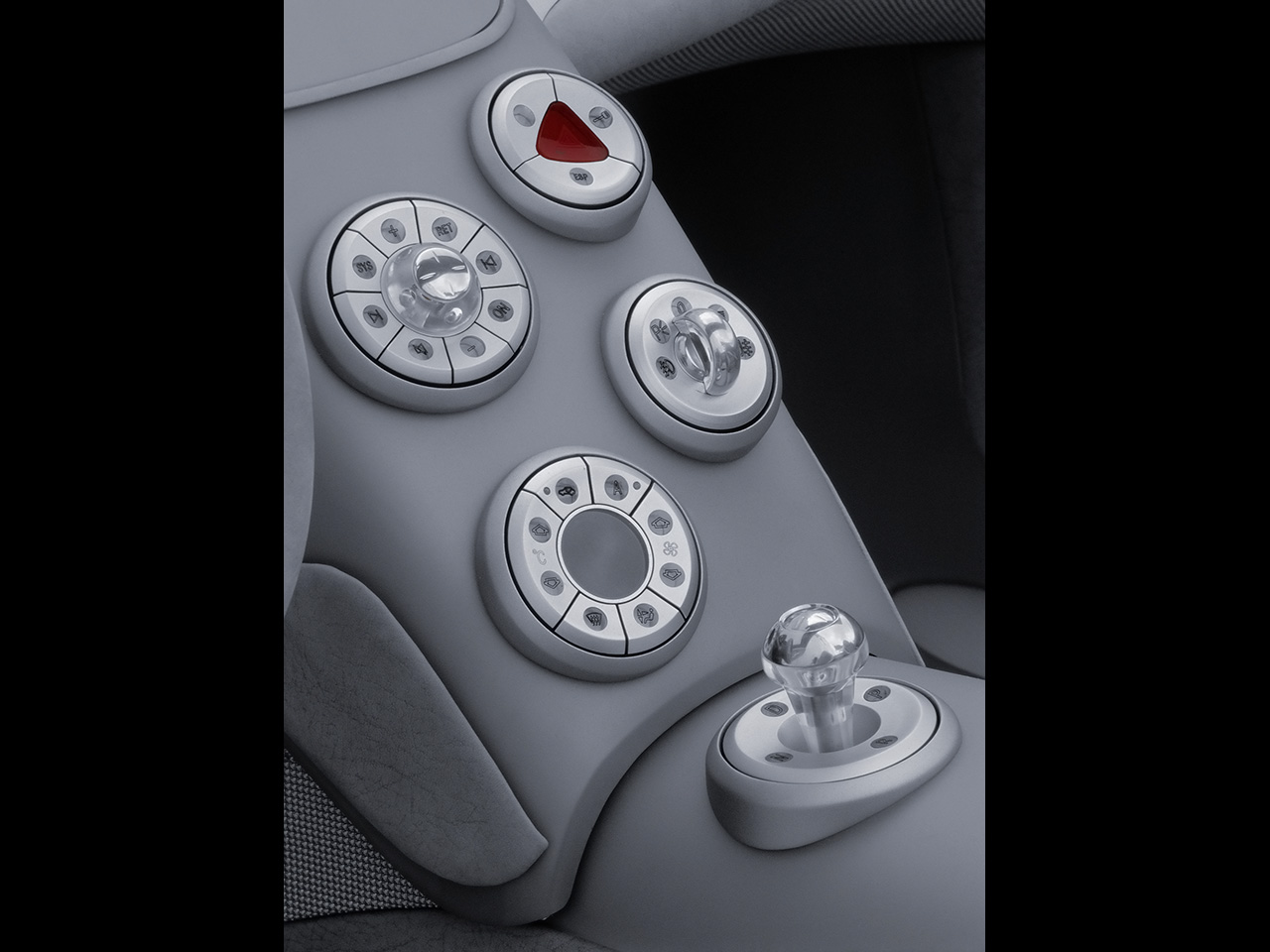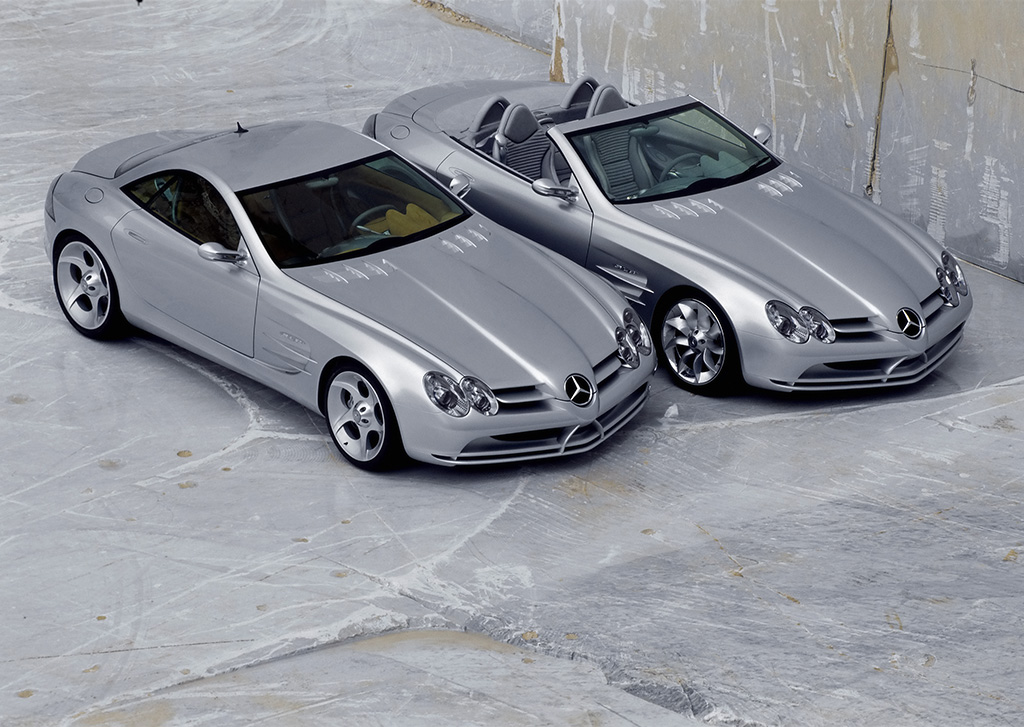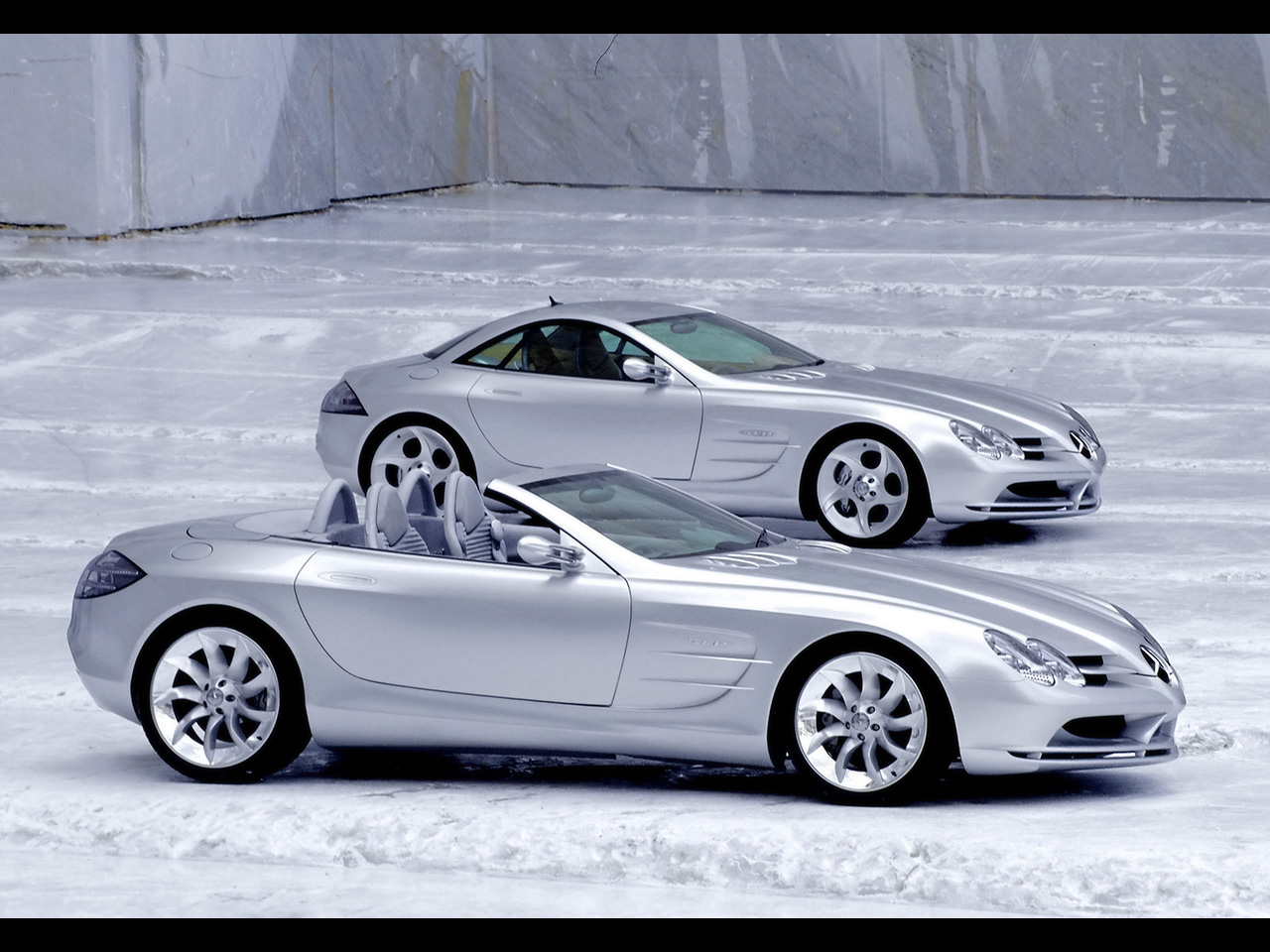1999 Mercedes-Benz Vision SLR Roadster
|
Price |
-- |
Production |
-- | ||
|
Engine |
5.5 liter V8 |
Weight |
-- | ||
|
Aspiration |
supercharger & intercooler |
Torque |
531 lb-ft @ 4000 rpm | ||
|
HP |
557 hp |
HP/Weight |
-- | ||
|
HP/Liter |
101.4 hp per liter |
0-124 mph |
11.3 seconds (hardtop) | ||
|
0-62 mph |
4.2 seconds (hardtop) |
Top Speed |
199 mph (hardtop) |
(from DaimlerChrysler Press Release)
Vehicle: Vision SLR
When: January 1999
Where: North American International Auto Show, Detroit
What: High-performance sports car
Powertrain: Four-stroke eight-cylinder engine, 5.5 liter
displacement, supercharged, 410 kW (557 hp), rear-wheel drive,
five-speed automatic transmission with Touchshift control
Technical highlights
Chassis consisting of
fiber composites and aluminum -> introduced 2003 in the
Mercedes-Benz SLR McLaren (C 199)
Carbon fiber bucket seats -> introduced 2003 in the
Mercedes-Benz SLR McLaren (C 199)
Electrohydraulic brake system -> introduced 2001 as
Sensotronic Brake Control (SBC) in the Mercedes-Benz SL (R 230)
Brake discs made of fiber-reinforced ceramic -> introduced
2003 in the Mercedes-Benz SLR McLaren (C 199)
Front headlamps with adaptive lighting system -> introduced
2003 as bi-xenon headlamps with Active Light System in the
Mercedes-Benz E-class (W 211)
Bi-functional xenon projector-beam headlamps for both low and
high beam -> introduced 2003 in the Mercedes-Benz SLR McLaren (C
199)
LED tail lights -> introduced 2003 in the Mercedes-Benz SLR
McLaren (C 199)
Rear license plate illuminated by a special luminescent film
The Vision SLR was
presented at the Detroit Auto Show in 1999 as "Tomorrow's Silver
Arrow". This claim was reflected in every aspect of the concept
vehicle. Designed as a Gran Turismo for the 21st century, it
incorporated styling themes from the current Silver Arrow Formula
One racecars and from the SLR sports cars of the 1950's, weaving
them together into a new and fascinating design.
The body of the Vision SLR expressed dynamism and power. The
striking front section with the V-shaped nose and the distinctive
twin-airfoil design – a motif which was repeated at various points
around the body and in the interior and was inspired by the Formula
One racecars – harmonized with the four-headlamp design familiar
from other models. The long and extended hood, the powerfully
sculpted fenders and the gullwing doors of the Vision SLR were based
on styling ideas first seen in the legendary SL models of the
fifties and their SLR racing versions, in which Juan Manuel Fangio,
Karl Kling and Stirling Moss romped from victory to victory.
Expressive but by no means aggressive, the Vision SLR displayed a
muscular body whose every fiber was taut and honed, poised to go
into action at a moment's notice.
A dominant interior design feature was the wide, gently curving
center console, with its circular controls, and the silver-painted
"spoiler fins" facing the driver and front passenger. These features
replaced a conventional instrument panel and at the same time
symbolized the state-of-the-art lightweight construction of the Gran
Turismo. The cockpit featured two round, aluminum-rimmed instrument
dials which recalled high-quality chronometers. These two dials –
the speedometer and rev counter – featured a new technique which
allowed them to accommodate other displays in their center.
Traditional instrument needles had been replaced by indicators which
moved on transparent plastic discs, so giving an unimpeded view of
the displays. Carbon bucket seats, an oval steering wheel and
state-of-the-art information technology such as the Cockpit
Management and Data System (COMAND) were further notable features of
the sporty interior.
The Vision SLR's chassis was made of a combination of fiber
composites and aluminum which offered outstanding crash performance
and also brought weight savings of approximately 40 percent compared
with conventional steel designs. These materials were used in those
areas where they brought the biggest advantages. The front crumple
zones, which deformed to a predetermined pattern, were made of
aluminum, while for the passenger compartment fiber composites were
used. The extreme strength of these fiber composite components
maximized occupant survival space even in a very severe frontal or
rear-end collision.
For the first time in a Mercedes-Benz, an electrohydraulic brake
system was used. This system used sensors and microcontrollers to
precisely calculate the right braking pressure in a given situation,
thus providing significantly enhanced safety when cornering or when
driving on a slippery surface. Under the name Sensotronic Brake
Control (SBC), the system first went into production in the SL (R
230), premiered in 2001. The brake discs were made of
fiber-reinforced ceramic and were capable of withstanding extreme
stresses.
The front headlamps with adaptive lighting system and innovative
high-performance diodes automatically followed the direction in
which the driver was steering, thereby adapting to different driving
situations. The result was significantly improved road illumination
when cornering or making a turn. The xenon projector-beam headlamps
provided both the low beam and the high beam, and the Mercedes
engineers therefore referred to them as "bi-functional". This
technology is based on shutters which, as well as ensuring precise
compliance with the legal requirements on dipped beam range,
automatically move out of the way when the high beam is switched on,
thus allowing the full light output to be used. The high beam is
supplemented by two long-distance spotlights.
The LED rear lights were particularly effective at warning when the
vehicle was braking or making a turn. They were mounted on two
"floating" fins positioned one above the other which showed a close
tie-in with the overall styling themes. A further light strip
extended right the way across the vehicle above the rear bumper and
housed the reversing light and the rear fog lamp, both of which were
based on space-saving, high-performance neon technology. The rear
license plate meanwhile was illuminated by means of a special
luminescent film.
The Mercedes-Benz high-performance sports car concept was powered by
a modified version of the high-torque naturally aspirated V8 engine
used in the S-class. Equipped with supercharging and an air-to-water
intercooler, the 5.5 liter V8 developed maximum power of 410 kW (557
hp) in the Vision SLR, making it one of the most powerful engines in
this displacement category. Maximum torque of 720 Newton meters came
on stream at 4000 rpm, with 580 Newton meters already available at
just 2000 rpm. The transmission was a five-speed automatic with
Touchshift control. Performance was formidable, with a 0 - 100 km/h
time of just 4.2 seconds and a 0 - 200 km/h time of 11.3 seconds, on
the way to a top speed of 320 km/h.
Later in 1999, at the Frankfurt Motor Show (IAA), Mercedes-Benz
presented the roadster version of the Vision SLR. In terms of
styling and engineering it closely resembled the all-enclosed
version, although some new themes were also aired, such as a soft
top made of an innovative translucent material.
Ever since it was first unveiled in 1999, Vision SLR has represented
Mercedes-Benz's idea of an exclusive sports car. There will be
little change on that score even after the start of "volume"
production in 2004, since only 3,500 units are planned. Prior to the
start of production various refinements were made to the bodywork
and also to the engine, which now develops maximum power of 460 kW
(626 hp) at 6500 rpm, with maximum torque of 780 Nm available
between 3250 and 5000 rpm. As these figures indicate, the SLR is
every inch a high-performance sports car. But with all the
refinement of a Mercedes-Benz.



